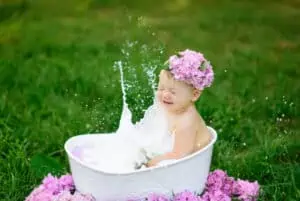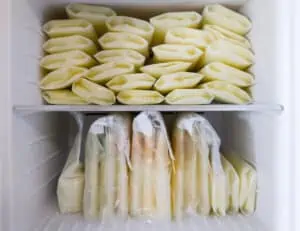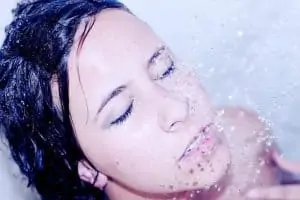Recently, I’ve been talking a bit about breast milk baths. We all know the magical wonders of breast milk, or at least you should when you’re reading my blog.
But what is the best milk for toddlers with eczema? Can you do a breast milk bath for eczema? I keep getting all sorts of questions about how to do it, if it’s safe, if you can do an oatmeal and milk bath for eczema, and so much more.
So, I thought I’d make this post all about the various types of milk baths, including breast milk baths, oat milk baths for eczema, and a milk bath for baby without breast milk.
Is a milk bath good for eczema?
According to Healthline, milk baths are not a good idea for all, especially if you have sensitive skin. In particular, there are few studies to support the benefits when it comes to eczema in particular.

However, human breast milk was shown in one study to work as well as hydrocortisone for treating babies with eczema. If you’re thinking about giving your baby with eczema a breast milk bath, my advice is to talk to your pediatrician first. Ditto for a breast milk bath for baby acne, which is also said to be helpful.
And if you’re inquiring about your own skin, ask your dermatologist if they think any kind of milk bath would benefit your situation.
What kind of milk are you able to use for a milk bath?
The good thing about a milk bath is that you can use pretty much any type of milk. There’s breast milk, cow’s milk, buttermilk, coconut milk, powdered milk, rice milk, soy milk, and goat’s milk.
As mentioned above, there’s not a whole lot of evidence about the benefits of milk baths from the scientific community. So, there’s no telling which may be more effective than another, or even if there is a difference.
However, one milk to avoid is skim milk. There’s nothing wrong with it per se, but it won’t give your skin the kind of nourishment that whole milk can provide it.
How to do a milk bath for a baby?
Making a milk bath for a baby is really easy, much like a regular bath. You’ll undoubtedly want to use a baby tub for newborns or even the sink to make it easier on you when the baby is too little to sit up on her own. And you’ll want to follow safe bath protocols for babies too.
To make a DIY milk bath, simply add 1 to 2 cups of milk to your tub of lukewarm water. This can be any kind of milk discussed above, as long as the pediatrician thinks it’s a good idea. You can add a couple of scoops to the water with powdered milk varieties to do the trick.

Again, ANY milk can be used from the list above, but it’s always wise to check with the doctor since you don’t want it causing any irritations to the baby’s skin.
The water will then appear milky in color. When it has that cloudy look, you can add baby to it for about 5 to no more than 15 minutes (10 should really be the limit for babies).
You can then pat your baby dry, following with a safe moisturizer to help lock that hydration into the skin.
What about add-ins?
Great question! You can add things like oatmeal to the milk bath too!
Oatmeal has been shown to help keep skin moisturized, and it can be excellent for treating eczema. Again, ask the doctor, but oatmeal can help repair that breached skin barrier, which gets skin to heal, locks that moisture in, and prevents skin from becoming dried out. Plus, it soothes redness, irritation, itching, and tenderness.
If you’re going to add oatmeal to the milk bath, add just a cup of it into the tub.
Please note these measurements are for a full-sized tub.
So if you have a baby tub, you may want to add a little at a time of whichever milk you choose until the water is cloudy, and then gradually add the oatmeal. It should not look like your morning breakfast in that tub!
Should I rinse after a milk bath?
If it is just a milk bath for your baby, especially with breast milk, there’s really no need to rinse your baby off. Just pat them dry and apply moisturizer to the magic of the breast milk can happen.
However, for adults taking a milk bath or using milk baths with oatmeal in them, it may be wise to take a quick rinse first. Be sure you immediately apply moisturizer as soon as you towel off.
How long should you soak in a milk bath?
For babies, a milk bath soak should be capped at 5 to 10 minutes for babies and never longer than 15 minutes. But if the milk bath is for you, you can go for 10 to 20 minutes. I don’t know about you, but I can’t soak any longer than that myself. The water tends to feel too cold to me by then, and I want out!
Does a milk bath have to be breast milk?
Oh, no, it surely doesn’t need to be breast milk. Again, there are limited studies about how milk baths can help the skin. While there is the one about breast milk I cited above, I’d love to see more scientific evidence backing it up.
Any kind of milk can be used though if you or your baby have eczema, other skin conditions, or milk allergies, it is an excellent idea to check with the doctor. You don’t want to make your skin worse.
While we wait for science to provide further backing, it might help you know that this milk bath practice stems from the ancient Romans. Cleopatra, too was said to have such gorgeous skin, attributed to bathing in a mixture of milk and honey.
I would refrain from adding honey to a bath for any child under 1. The risk for botulism by consuming honey is too high, and if your baby accidentally swallows any bathwater with honey in it, that’s a bad thing.
Can you use expired breast milk for a milk bath?
Well, I mentioned this recently, but milk beyond its expiration date may be fine for a bath. That’s to say that it should be fine as long as it doesn’t stink. So if you have had it in the freezer or fridge a week or two longer than planned, don’t feed it to the baby.
Give that breast milk a sniff and see if it still smells okay. It’s a great idea to use it in a bath to keep from wasting it. You don’t want to give expired milk to your baby, or you could make her sick.
In case, you are wondering how many times you can reheat breastmilk, here is my suggestion.
Final thoughts on milk baths…
Milk baths should be fine for your baby, toddler, and you. But with certain skin conditions, you’ll want to talk to your doctor about your specific situation. Breast milk has some great benefits for the skin, but other types of milk, from coconut milk to goat’s milk, can also be soothing and nourishing.
Not to mention, it’s pretty relaxing too, so enjoy that moment of peace while you can get it!
Leslie Berry lives with her husband and two young daughters in Los Altos, California, where she loves helping other moms get comfortable with motherhood and embracing the insanity with facts peppered with laughs.
She loves eating too much sushi, exercising, and jamming out on her Fender. Read more about Leslie here.






